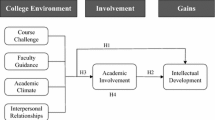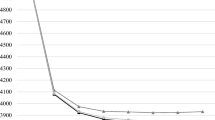Abstract
The purpose of this study was to provide further evidence on potential determinants of college student involvement in curricular and cocurricular campus activities, particularly on the importance of student enrollment in three academic programs. The study focused on how students in two special academic programs—an honors program and a transition program to assist academically disadvantaged students adjust to college—as well as students in the regular curriculum become engaged in a variety of experiences and how their quality of effort (involvement) in the activities is related to student growth and development. The relationship between level of student activity and achievement supports the claims of previous research that involvement contributes to students' development and gains in intellectual and interpersonal areas. However, the strength of relationship between student effort and gain varied for the three groups. Overall, the honors and transition students appeared to get more for their effort than did the regular students.
Similar content being viewed by others
References
Astin, A. W. (1977).Four Critical Years: Effects of College on Beliefs, Attitudes, and Knowledge. San Francisco: Jossey-Bass.
Astin, A. W. (1984). Student involvement: A developmental theory for higher education.Journal of College Student Personnel 25: 297–308.
Bean, J. P., and Kuh, G. D. (1984). The reciprocity between student-faculty informal contact and academic performance of university undergraduate students.Research in Higher Education 17: 292–320.
Campus Honors Program Student Handbook. (1988). Urbana-Champaign, Ill: University of Illinois.
Huang, P., and Braskamp, L. A. (1988). The utility of personal incentives. Paper presented at Annual Meeting of Association of Institutional Research, Phoenix.
Maehr, M. L., and Braskamp, L. A. (1986).The Motivation Factor: A Theory of Personal Investment. Lexington, Mass.: Lexington Books.
National Institute of Education (1984). Involvement in learning: Realizing the potential of American higher education.
Pace, C. R. (1979).College Student Experiences Questionnaire. Los Angeles: UCLA, Center for the Study of Evaluation.
Pace, C. R. (1986).Separate Paths to Separate Places. Los Angeles: UCLA, Center for the Study of Evaluation.
Pace, C. R. (1987).Good Things Go Together. Los Angeles: UCLA, Center for the Study of Evaluation.
Pascarella, E. (1986). Are value-added analyses valuable? InAssessing the outcomes of higher education (pp. 71–91). Proceedings of the 1986 ETS Invitational Conference, Princeton, N.J.
Terenzini, P. T., and Pascarella, E. T. (1978). The relation of students' precollege characteristics and freshman year experience to voluntary attrition.Research in Higher Education 9: 347–366.
Wilder, M. A., and Kellams, S. E. (1987). Commitment to college and student involvement. Paper presented at annual meeting of American Educational Research Association, Washington, D.C.
Author information
Authors and Affiliations
Rights and permissions
About this article
Cite this article
Ory, J.C., Braskamp, L.A. Involvement and growth of students in three academic programs. Res High Educ 28, 116–129 (1988). https://doi.org/10.1007/BF00992886
Received:
Issue Date:
DOI: https://doi.org/10.1007/BF00992886




